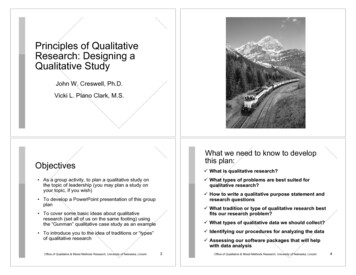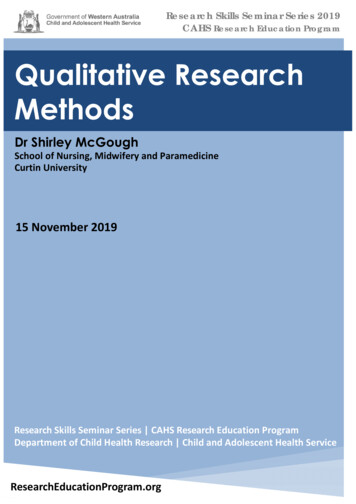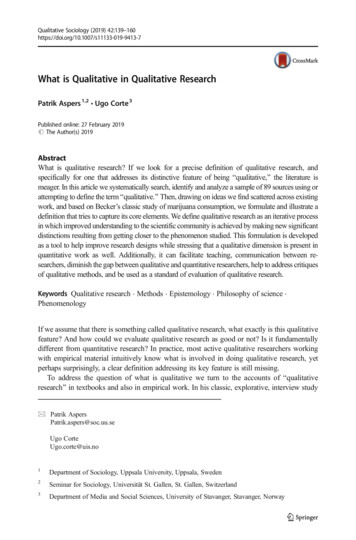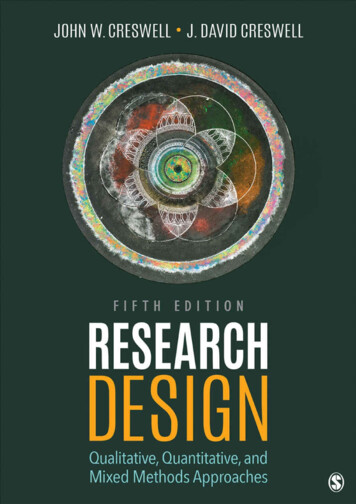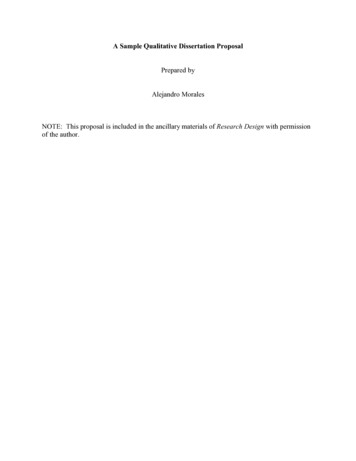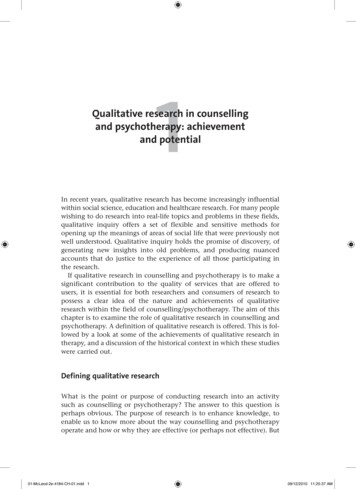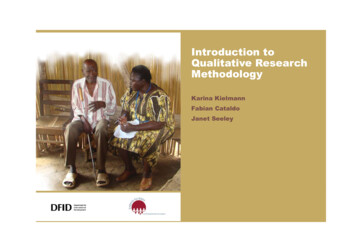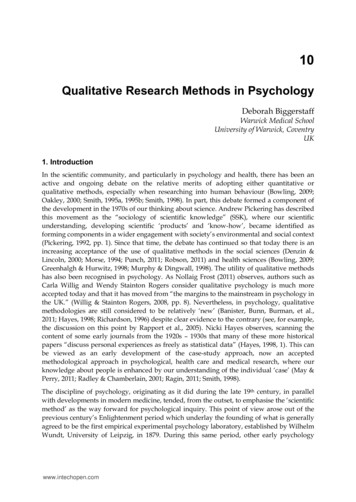
Transcription
10Qualitative Research Methods in PsychologyDeborah BiggerstaffWarwick Medical SchoolUniversity of Warwick, CoventryUK1. IntroductionIn the scientific community, and particularly in psychology and health, there has been anactive and ongoing debate on the relative merits of adopting either quantitative orqualitative methods, especially when researching into human behaviour (Bowling, 2009;Oakley, 2000; Smith, 1995a, 1995b; Smith, 1998). In part, this debate formed a component ofthe development in the 1970s of our thinking about science. Andrew Pickering has describedthis movement as the “sociology of scientific knowledge” (SSK), where our scientificunderstanding, developing scientific ‘products’ and ‘know-how’, became identified asforming components in a wider engagement with society’s environmental and social context(Pickering, 1992, pp. 1). Since that time, the debate has continued so that today there is anincreasing acceptance of the use of qualitative methods in the social sciences (Denzin &Lincoln, 2000; Morse, 1994; Punch, 2011; Robson, 2011) and health sciences (Bowling, 2009;Greenhalgh & Hurwitz, 1998; Murphy & Dingwall, 1998). The utility of qualitative methodshas also been recognised in psychology. As Nollaig Frost (2011) observes, authors such asCarla Willig and Wendy Stainton Rogers consider qualitative psychology is much moreaccepted today and that it has moved from “the margins to the mainstream in psychology inthe UK.” (Willig & Stainton Rogers, 2008, pp. 8). Nevertheless, in psychology, qualitativemethodologies are still considered to be relatively ‘new’ (Banister, Bunn, Burman, et al.,2011; Hayes, 1998; Richardson, 1996) despite clear evidence to the contrary (see, for example,the discussion on this point by Rapport et al., 2005). Nicki Hayes observes, scanning thecontent of some early journals from the 1920s – 1930s that many of these more historicalpapers “discuss personal experiences as freely as statistical data” (Hayes, 1998, 1). This canbe viewed as an early development of the case-study approach, now an acceptedmethodological approach in psychological, health care and medical research, where ourknowledge about people is enhanced by our understanding of the individual ‘case’ (May &Perry, 2011; Radley & Chamberlain, 2001; Ragin, 2011; Smith, 1998).The discipline of psychology, originating as it did during the late 19th century, in parallelwith developments in modern medicine, tended, from the outset, to emphasise the ‘scientificmethod’ as the way forward for psychological inquiry. This point of view arose out of theprevious century’s Enlightenment period which underlay the founding of what is generallyagreed to be the first empirical experimental psychology laboratory, established by WilhelmWundt, University of Leipzig, in 1879. During this same period, other early psychologywww.intechopen.com
176Psychology - Selected Papersresearchers, such as the group of scientific thinkers interested in perception (the Gestaltists:see, for example, Lamiell, 1995) were developing their work. Later, in the 20th century, theintroduction of Behaviourism became the predominant school of psychology in Americaand Britain. Behaviourism emphasised a reductionist approach, and this movement, until itsdisplacement in the 1970-80s by the ‘cognitive revolution’, dominated the discipline ofpsychology (Hayes, 1998, pp. 2-3). These approaches have served the scientific communitywell, and have been considerably enhanced by increasingly sophisticated statisticalcomputer programmes for data analysis.A recent feature of the debate in the future direction for psychology has been a concern forthe philosophical underpinnings of the discipline and an appreciation of their importance.In part, this is an intrinsic part of theoretical developments in psychology and the relatedsocial sciences, in particular sociological research, such as Grounded Theory, developed bythe sociologists Glazer and Strauss during the 1960s and 1970s (e.g. Charmaz, 1983; Glaser &Strauss, 1967; Searle, 2012); modes of social inquiry such as interviewing and contentanalysis (Gillham, 2000; King & Horrocks, 2010); action research (Hart & Bond, 1999;Sixsmith & Daniels, 2011); discourse and discourse analysis (Tonkiss, 2012; Potter &Wetherell, 1995); narrative (Polkinghorne, 1988; Reissman, 2008); biographical researchmethods (Roberts, 2002); phenomenological methods (Giorgi,1995; Langdridge, 2007;Lawthom &Tindall, 2011; Smith et al., 2009 ); focus groups (Carey, 1994; Vazquez-Lago etal., 2011); visual research methods (Mitchell, 2011); ethnographic methods (Boyles, 1994;Punch, 2011); photo-biographic-elicitation methods (Rapport et al., 2008); and, finally, thecombining or integrating of methods, the approach often known as ‘mixed methods’ (Frost,2011; Pope et al., 2007; Thomas et al., 2004; Todd et al., 2004).Qualitative methods have much to offer when we need to explore people’s feelings or askparticipants to reflect on their experiences. As was noted above, some of the earliestpsychological thinkers of the late 19th century and early 20th century may be regarded asproto-qualitative researchers. Examples include the ‘founding father’ of psycho-analysis,Sigmund Freud, who worked in Vienna (late 19th century – to mid 20th century), recordedand published numerous case-studies and then engaged in analysis, postulation andtheorising on the basis of his observations, and the pioneering Swiss developmentalpsychologist, Jean Piaget (1896 – 1980) who meticulously observed and recorded hischildren’s developing awareness and engagement with their social world. They weresucceeded by many other authors from the 1940s onwards who adopted qualitativemethods and may be regarded as contributors to the development of qualitativemethodologies through their emphasis of the importance of the idiographic and use of casestudies (Allport,1946; Nicholson, 1997)1 . This locates the roots of qualitative thinking in thelong-standing debate between empiricist and rationalistic schools of thought, and also insocial constructionism (Gergen, 1985; King & Horrock, pp. 6 – 24)2.1 Allport states “[ ] among the methods having idiographic intent, and emphasised by me, are the casestudy, the personal document, interviewing methods,matching, personal structure analysis, and otherprocedures that contrive to keep together what nature itself has fashioned as an integrated unit – thesingle personality.” (Allport, 1946, pp. 133).2 A notable milestone in the development of qualitative methodologies in the UK for example, was thepublication, in 1992, of a paper proposing a role for qualitative methods for psychology, by KarenHenwood and Nick Pigeon in the British Journal of Psychology.www.intechopen.com
Qualitative Research Methods in Psychology177More recently, in the UK, the British Psychological Society now has a members’ section forQualitative Methods in Psychology (QMiP) which held a successful inaugural conference, in2008, at the University of Leeds. The Section now boasts a membership of more than 1000members, making it one of the largest BPS Sections. The undergraduate psychologycurriculum, which confers BPS graduate basis for registration (GBR), now includesqualitative research methods teaching in the core programme for UK universities degrees.Elsewhere, qualitative psychology has taken a little longer to be accepted e.g. by theAmerican Psychological Association (APA). This is somewhat surprising given the largevolume of qualitative research papers which originate from the American researchcommunity. However, US researchers, alongside their international colleagues, have finallymanaged to petition successfully for the inclusion of qualitative methodologies to beadmitted to Section 5, the methodology section, of the APA, during 2011.These developments can be tracked by a search for qualitative research across the mainelectronic databases and exploring the ‘hits’ recovered. A quick scan using the umbrellaterms ‘qualitative’ and / or ‘qualitative research’ for example, provides the researcher with aresult for a relatively low number of papers from the earlier years of last century. Howeverthere is a noticeably sharp increase in the number of papers published from 1990 onwards.A search of the main databases, using the term “qualitative” as a key word (January, 1990 December, 2011) produced a retrieval rate for qualitative papers of over 51744 hits(CINAHL); 122012 hits (PsycInfo); 12108 for Medline (OVID); and 18431 for Applied SocialSciences Index and Abstracts (ASSIA). Prior to 1990 the number of papers recorded in thesedatabases is noticeably lower: searching in ASSIA for papers published between 1985 – 1990,for example, results in 13 papers, while a Medline search for the years 1985 – 1990 returns 6papers. Searching in CINAHL for the same period (1985 – 1990) results in no papers (zeroresult).2. What is qualitative psychology?So, what exactly is qualitative research? A practical definition points to methods that uselanguage, rather than numbers, and an interpretative, naturalistic approach. Qualitativeresearch embraces the concept of intersubjectivity usually understood to refer to how peoplemay agree or construct meaning: perhaps to a shared understanding, emotion, feeling, orperception of a situation , in order to interpret the social world they inhabit (Nerlich, 2004,pp. 18). Norman Denzin and Yvonna Lincoln define qualitative researchers as people whousually work in the ‘real’ world of lived experience, often in a natural setting, rather than alaboratory based experimental approach. The qualitative researcher tries to make sense ofsocial phenomena and the meanings people bring to them (Denzin & Lincoln, 2000)3.In qualitative research, it is acknowledged that the researcher is an integral part of theprocess and who may reflect on her/his own influence and experience in the research(See Henwood, K. & Pidgeon, N. (1992) Qualitative research and psychological theorising. BritishJournal of Psychology, 83: 97 – 111).3 For readers interested in more on the history of the philosophy of science and its relationship todevelopments in psychology, I recommend the following authors: Andrew Pickering (1992); JohnRichardson (1996); Mark Smith (1998); Clive Seale (2012); and especially Jonathan Smith and colleagueswith the publication of Rethinking Methods in Psychology (Smith et al., 1995b).www.intechopen.com
178Psychology - Selected Papersprocess.4 The qualitative researcher accepts that s/he is not ‘neutral’. Instead s/he putsherself in the position of the participant or 'subject' and attempts to understand how theworld is from that person's perspective. As this process is re-iterated, hypotheses begin toemerge, which are 'tested' against the data of further experiences e.g. people's narratives.One of the key differences between quantitative and qualitative approaches is apparenthere: the quantitative approach states the hypothesis from the outset, (i.e. a ‘top down’approach), whereas in qualitative research the hypothesis or research question, is refinedand developed during the process. This may be thought of as a ‘bottom-up’ or emergentapproach, as, for example, in Grounded Theory (Charmaz, 1995).This contrast is part of theepistemological positions that shape our assumptions about the world. King and Horrockssummarise some of these main differences in position as being either realist, contextual orconstructionist. They compare these to assumptions about the world, the knowledgeproduced and the role of the researcher (King & Horrocks, 2010). These authors, along withothers, such as Colin Robson, advocate adopting a pragmatic approach to qualitativeresearch. As Robson observes, “Pragmatism is almost an ‘anti-philosophical’ philosophywhich advocates getting on with the research rather than philosophizing – hence providinga welcome antidote to a stultifuying over-concern with matters such as ontology andepistemology.” (Robson, 2011, pp.30)5.It may be helpful to think of qualitative research as situated at one end of a continuum withits data from in-depth interviews, and with quantitative ‘measurable’ data at the other end(see Figure 1). At the centre-point of this continuum may rest such data as content analysisand questionnaire responses transformed from the written or spoken word into numerical‘codes’ for statistical analysis. Examples include standardised questionnaires, e.g. fordepression and anxiety such as Hospital Anxiety and Depression Scale (HADS), or Beck’sDepression Inventory. With limited space given on questionnaires, respondents can onlygive the briefest answers to pre-formulated questions from the researchers. Respondents’replies are coded and ‘scored’, but does that mean that we can measure feelings or emotion?How do we 'calculate' levels of depression or anxiety? How does the experience ofdepression affect people’s lives? Have we, as researchers, asked appropriate questions in thefirst place? Qualitative research methodology looks to answer these types of questions – theexploratory approach. An example of this exploratory approach is Jonathan Smith’s workexamining young mothers’ lived-world experiences of the psychological transition tomotherhood (see, for example, Smith, 1999; 1998; 1994).This is in contrast to the positivist, hypothetico-deductive methodology, associated with the philosopherKarl Popper, and enthusiastically adopted by the psychology discipline, of 'refuting the nullhypothesis', commonly taken to be the 'gold standard' of quantitative scientific research methodologyi.e. where hypotheses are defined at the start of the research (see, for example, Popper,1935/2002). Oneof the challenges however of attempting to fit the ‘scientific’ approach into researching humanbehaviour, is that sometimes this scientific experimental methodology, the design of which originates inthe laboratory, may not quite provide what is needed when attempting to investigate psychological andhuman behaviours. The Medical Research Council (MRC) in the UK also acknowledges this. In 2008they provided new guidance to their 2000 MRC Framework for the development and evaluation of RCTs forcomplex interventions to improve health to include non-experimental methods, and complex interventionsoutside healthcare. ndex.htm?d MRC0048715 See also Robson, 2011, pp. 30 – 35 for further discussion on this topic.4www.intechopen.com
179Qualitative Research Methods in PsychologyEpistemological s about theworldThere existsunmediated accessto a ‘real’ worldwhere process andrelationships can berevealedContrast is integralto understandinghow peopleexperience theirlivesSocial reality isconstructedthrough languagewhich producesparticular versionsof eventsKnowledge producedSeeks to produceobjective datawhich is reliableand likely to berepresentative ofthe widerpopulation fromwhich the interviewsample is drawnRole of researcherResearcher aims toavoid bias. Remainsobjective anddetachedData are inclusiveof context aiming toadd to the‘completeness’ ofthe analysis bymaking visiblecultural andhistorical meaningsystemsSubjectivity ofresearcher isintegral to process.Researcher active indata generation andanalysisDoes not adhere totraditionalconventions.Knowledge broughtinto being throughdialogueResearcher ‘coproducer’ ofknowledge.Therefore needs tobe reflexive andcritically aware(e.g. of language)Source: adapted from King & Horrocks, 2010, pp. 20Table 1. Epistemological positions that shape our worldToday, a growing number of psychologists are re-examining and re-exploring qualitativemethods for psychological research, challenging the more traditional ‘scientific’experimental approach (see, for example, Gergen, 1991; 1985; Smith et al., 1995a, 1995b).There is a move towards a consideration of what these other methods can offer topsychology ( Bruner, 1986; Smith et al.,1995a). What we are now seeing is a renewed interestin qualitative methods which has led to many researchers becoming interested in howqualitative methods in psychology can stand alongside, and complement, quantitativemethods. This is important, since both qualitative and quantitative methods have value tothe researcher and each can complement the other albeit with a different focus6 (Crossley,2000; Dixon-Wood & Fitzpatrick, 2001; Elwyn, 1997; Gantley et al., 1999; Rapport et al.,2005). Seminal qualitative-focused works from authors such as Jerome Bruner, DonaldPolkinghorne and Jonathan Smith and colleagues’ in the early 1990s highlight theimportance of ‘re-discovering’ qualitative methods in the field (Bruner, 1990, 1991, 2000;Polkinghorne, 1988; Smith et al., 1995a; 1995b).6I thank the book’s editor, Gina Rossi for this helpful comment.www.intechopen.com
180Psychology - Selected PapersSource: adapted from Henwood, 1996.Fig. 1. The quantitative – qualitative continuumJonathan Smith and his colleagues, for example, announce at the beginning of theirRethinking psychology, that “Psychology is in a state of flux” with an “unprecedented degreeof questioning about the nature of the subject, the boundaries of the discipline and whatnew ways of conducting psychological research are available.” (Smith et al., 1995a, pp. 1).Rom Harré, heralded these new ways of thinking as marking the ‘discursive turn’ (Harré,1995a, pp. 146), while Ken Gergen, writes about there being a ‘revolution in qualitativeresearch’ (Gergen, 2001, pp. 3).Additionally, as Karen Henwood suggests, integrating qualitative with quantitativemethods in psychology also provides researchers with a tool for the potential“democratisation of the research process”. She observes how among clinical psychologistsworking in the United Kingdom’s National Health Service (NHS) for instance, the researchprocess can be “opened to include the views of service users”with an increasing emphasison exploring “people’s personal and cultural understandings and stocks of knowledge”(Henwood, 2004, pp. 43). Henwood suggests that integrating methods may thus also helpestablish and embed research validity by communicating responsibly and honestly whenexploring multiple perspectives.In a parallel movement, qualitative methods have also come to be increasinglyacknowledged across the social sciences more generally (Banister, et al. 2011; Oakley, 2000;www.intechopen.com
Qualitative Research Methods in Psychology181Potter, 1996; Radley & Chamberlain, 200; Richardson, 1996; Strauss & Corbin, 1990; Willig,2008). Meanwhile, as already noted above, the use of narrative and meaning in psychologyand the human sciences also re-emerged (Bruner, 1990, 1991; Crossley, 2000; Polkinghorne,1988; Reissman, 2008). Interestingly, Polkinghorne observes that, in contrast to other relateddisciplines in the social sciences, psychology very largely ignored the use of narrative untilthe end of the 1980s – early 1990s with a shift towards a "renewed interest in narrative as acognitive structure" (Polkinghorne, 1988, pp. 101) as an element in the field of cognitivepsychology. Polkinghorne suggests that the re-emergence of narrative thinking inpsychology took place during this period due to the increased attention being given bypsychologists to the utility of exploring life histories, self-narrative (for example inestablishing one’s personal identity) and a renewal of interest in the case study andbiographical research (Roberts, 2002). Polkinghorne, along with other authors, such asJerome Bruner (1990, 1991, 2002) and Ricoeur (1981/1995) proposes that our use of narrativeis linked to the perception of time and our place in the lived-world where“[.] people use self-stories to interpret and account for their lives. The basic dimensionof human existence is temporality, and narrative transforms the mere passing away oftime into a meaningful unity, the self. The study of a person’s own experience of her orhis life-span requires attending to the operations of the narrative form and how this lifestory is related to the stories of others.”(Polkinghorne, 1988, pp. 119).During the same period, (i.e. over the past ten – fifteen years), psychology and social sciencejournals, such as the British Journal of Psychology, Journal of Health Psychology, Social Scienceand Medicine etc., as, indeed, did the British Medical Journal, began to include qualitativeresearch papers, indicating that a qualitative approach, in parallel with the quantitativescientific paradigm, can illuminate important areas in the behavioural sciences andpsychology. In the early days there was some debate about academic ‘rigour’ and validitysuggesting some unease about using qualitative methods, both in psychology and relatedareas. This is now much improved as researchers address these issues (Bloor, 1997; Henwood,2004; Yardley, 2008). However, this is less of a challenge today, with increasing acceptance ofthese methods and the introduction of appraisal checklists. Nevertheless, as with any research,poor understanding of the methodology and what it can offer, or the inappropriate selection ofa method, is likely to lead to poor quality results and the resultant lack of any real insight intothe area being explored. Today, the introduction of evidence-based tools such as the CriticalAppraisal Skills Programme (CASP) based at the Centre for Evidence Based Medicine,University of Oxford, include a qualitative paper checklist on their website providing evidenceof a much greater acceptance of these methods ogramme).Additionally, the British Psychological Society has now developed guidelines for theappraisal of qualitative papers indicating the wider academic acceptance of qualitativepsychology today. As Peter Banister and his colleagues note, writing in the preface to theirQualitative methods in psychology, in benchmarking UK psychology degrees, The QualityAssurance Agency of 2007, include a section on the need for students to cover bothquantitative and qualitative research methods. This includes being able to analyse bothtypes of data. This ability is now (2010) also highlighted as being a requirement forconferring of BPS Chartership status (Banister et al., 2011: vii - viii)www.intechopen.com
182Psychology - Selected PapersThus, in order to best gain insight into the field of qualitative psychology some of thisbackground knowledge of the specific theoretical and philosophical underpinnings outlinedearlier is needed by researchers today who decide to explore their chosen research topicusing qualitative methods. These theoretical and philosophical concerns inform thediscipline and it is important that the researcher understands this.2.1 Pluralism in qualitative research: Synthesizing or combining methodsThe importance of researching and studying people in as natural a way as possible isemphasised i.e. the ‘real world’ approach (Robson, 2011). This is contrasted with thepositivist approach of refuting the null hypothesis. The need for the researcher to put herselfin the position of the ‘subject’ in her attempt to understand how the world is from thatperson’s perspective is emphasised. King and Horrocks, for instance, discuss these different,sometimes competing ‘quant – qual’ approaches to research. These authors suggest that,while often presented as the challenge of two ‘paradigms,’ it may be an unhelpful way toapproach the quantitative – qualitative continuum (King & Horrocks, 2010, pp. 7). This isbecause some researchers today are beginning to think further about how we mightoptimise results by synthesizing qualitative and quantitative data to interpret our researchevidence. Thus, we may further understand (verstehen), our findings, by drawing on socialtheory, from Max Weber’s work (Whimster, 2001, pp. 59-64). This interpretive approach,originating, as it does, from the field of social sciences, aims to develop new conceptualunderstandings and explanations in social theory (Pope, et al., 2007, pp. 72 onward).Cresswell and Clark (2007) recognise that, in order to avoid losing potential value of somedata, it may be preferable to adopt ‘mixed methods’. This is often of value in, for example,health research where health evidence is needed from both quantitative and qualitativeperspectives. This helps bring together diverse types of evidence needed to informhealthcare delivery and practice (Pope et al., 2007). I offer some suggestions and guidancefor when either a qualitative or quantitative approach might be most useful, or alternatively,when it might be helpful to consider using combined methods i.e. a ‘mixed methods’approach. The research focus can then be viewed from a number of vantage points, theapproach known as triangulation (Banister et al., 2011; Huberman & Miles, 1998, pp. 199).Since triangulation is an approach which may be adopted across different qualitativemethods, this is discussed next.3. TriangulationThe term ‘triangulation’, according to Huberman and Miles, is thought to originate fromCampbell and Fiske’s 1959 work on “multiple operationalism” developed from geometryand trigonometry (Huberman & Miles, 1998). Huberman and Miles caution that the term‘triangulation’ may have more than one interpretation. However, it is usually used todescribe data verification of data, and considered as a method for“ checking for the most common or the most insidious biases that can steal into theprocess of drawing conclusions.”(Huberman & Miles, 1998, pp. 198)www.intechopen.com
Qualitative Research Methods in Psychology183When researchers employ triangulation, multiple measures are used to ensure that any datavariance is not due to the way in which the data were collected or measured. By linkingdifferent methods, the researcher intends that each method enhances the other, since all theinformation that is collected potentially offers to be contextually richer than if it were seenfrom only one vantage point. Each area provides a commentary on the other areas of theresearch (Frost, 2009). Triangulation can be a useful tool to examine data overload, whereresearchers analysing data may miss some important information due to an over-reliance onone portion of the data which could then skew the analysis. Another use is to providechecks and balances on the salience of first impressions. Triangulation is also a useful tool tohelp avoid data selectivity, such as being over-confident about a particular section of thedata analysis such as when trying to confirm a key finding, or without taking into accountthe potential for sources of data unreliability (Huberman & Miles, 1998, pp.198-9).It should be noted however, that, although triangulation is generally considered helpfulwhen using qualitative methods, it can just as equally be applied to quantitative or mixedmethods research. It is a pragmatic and strategic approach, whether applied to qualitative orqualitative research (Denzin & Lincoln, 1998). It may be viewed as providing a way ofexpanding the research perspective and becomes another means of strengthening researchfindings (Krahn et al.,1995).Banister et al. (2011) point out that any method of enquiry, whether quantitative orqualitative, can be open to bias and/or value laden, a fact that should be acknowledged,“[ ] a researcher and research cannot be value-free, and that a general ‘objectivist’notion that science can be value-free is impossible, given that we are all rooted in asocial world that is socially constructed. Psychology (at least in the West) has generalvalues (even if these are often left implicit) of communicating broadening knowledgeand understanding about people, with a commitment to both freedom of enquiry andfreedom of expression.”(Banister et al., 2011, pp. 204)Triangulation can help balance out, if not overcome, some of the challenges inherent inresearch, of whatever methodological persuasion (Todd et al., 2004). Triangulation can beseparated into four broad categories: data triangulation, investigator triangulation,triangulation of method and triangulation of theory.3.1 Data triangulationUsing one data origin may sometimes not be ideal. Collecting information from more thanone source can extend and enhance the research process. Banister and colleagues suggestthat more than one viewpoint, site, or source, increases diversity, thus leading to increasedunderstanding of the research topic (Banister et al., 2011; Cowman, 1993). The authorspropose it can be helpful to look at data collected at different times, or stages, of fieldwork,in order to re-evaluate (“research”) the material. This might mean checking if anything hasbeen overlooked or given too much emphasis, during the research process. The use oftriangulation can be very helpful when verification of data is needed, such as when doingaction research or an ethnography (Walsh, 2012, pp. 257 onward).www.intechopen.com
184Psychology - Selected PapersThe approach supports research being a reflexive, organic process, enriched by researchers’increasing depth of knowledge as they investigate the area (Finlay, 2003). This is linked tothe role of reflexivity in qualitative research, considered by many to be an essentialcomponent in qualitative inquiry (Banister et al., 2011, pp. 200-201; Frost, 2011, pp. 11-12).The researcher is expected to be able to stand back from the completed research andconsider, in retrospect, the selected methodology, whether the approach adopted suited theanalysis undertaken what the experience may have been like for both the researcher and theparticipants etc. Other factors which may be considered include whether flaws were foundin the research design, how the research study might be improved or refined, what furtherresearch might be needed etc. Some researchers advocate keeping a journal or diaryrecording these reflexions during the actual research process (Robson, 2011, pp. 270).3.2 Investigator triangula
qualitative research methods teaching in the core programme for UK universities degrees. Elsewhere, qualitative psychology has taken a little longer to be accepted e.g. by the American Psychological Association (APA). This is somewhat surprising given the large volume of qualitative r
